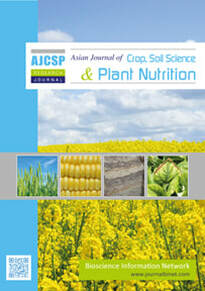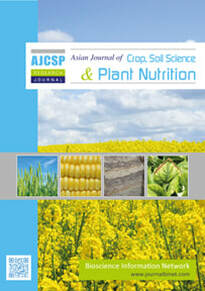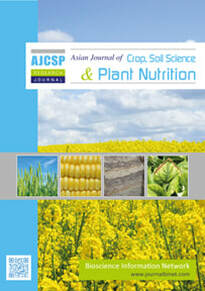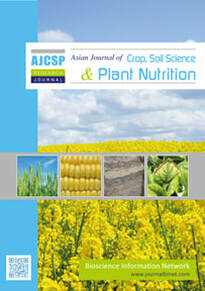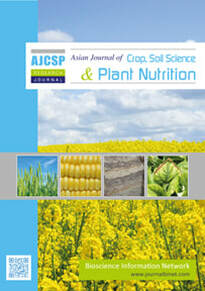Asian Journal of Crop, Soil Science and Plant Nutrition
Volume 06 - Issue 01 | Year of Publication: 2021
Article Type: Research Article | No. 26, 2021 | Country: Bangladesh | pp. 213-220 | Open Access
Title: Performance of different sugar beet genotypes under salinity stress
Authors: Hossain, M. S., Alam, M. I., Rahman, M. M., Mandal, P., Hasan, M. K. and Akter, S.
DOI: https://doi.org/10.18801/ajcsp.060121.26
Title: Performance of different sugar beet genotypes under salinity stress
Authors: Hossain, M. S., Alam, M. I., Rahman, M. M., Mandal, P., Hasan, M. K. and Akter, S.
DOI: https://doi.org/10.18801/ajcsp.060121.26
Performance of different sugar beet genotypes under salinity stress
Abstract
Soil salinity is one of the major threats which pose a detrimental threat against successful crop production. To tackle the salinity problem, intensive research is indispensable for sustainable crop production. A study was carried out to investigate the suitability of sugar beet genotypes and elucidate their yield-related characteristics in response to different saline conditions at the Sylhet region, Bangladesh, from October 2019 to March 2020. The treatment consists of four sugar beet genotypes viz., HI-0044, HI-0473, KWS-Allanya, and KWS-Serendara, and four NaCl levels viz., 0 mM NaCl (S0), 100 mM NaCl (S1), 200 mM NaCl (S2) and 300 mM NaCl (S3). In case of SPAD value for the chlorophyll content, all the genotypes showed their steady state in response to salinity stress. Based on growth pattern and yield performance, the highest values for all the parameters observed in the HI-0044 genotype followed by HI-0473, while KWS-Allanya and KWS-Serenada were the worst performers under different salinity stress. All the sugar beet genotypes showed the potentiality to maintain their growth and yield under low to high salinity levels with decreasing trends where HI-0044 genotype was the best performer under salinity stress.
Key Words: Soil salinity, Abiotic stress, Genotypes, Yield and Sugar beet.
Abstract
Soil salinity is one of the major threats which pose a detrimental threat against successful crop production. To tackle the salinity problem, intensive research is indispensable for sustainable crop production. A study was carried out to investigate the suitability of sugar beet genotypes and elucidate their yield-related characteristics in response to different saline conditions at the Sylhet region, Bangladesh, from October 2019 to March 2020. The treatment consists of four sugar beet genotypes viz., HI-0044, HI-0473, KWS-Allanya, and KWS-Serendara, and four NaCl levels viz., 0 mM NaCl (S0), 100 mM NaCl (S1), 200 mM NaCl (S2) and 300 mM NaCl (S3). In case of SPAD value for the chlorophyll content, all the genotypes showed their steady state in response to salinity stress. Based on growth pattern and yield performance, the highest values for all the parameters observed in the HI-0044 genotype followed by HI-0473, while KWS-Allanya and KWS-Serenada were the worst performers under different salinity stress. All the sugar beet genotypes showed the potentiality to maintain their growth and yield under low to high salinity levels with decreasing trends where HI-0044 genotype was the best performer under salinity stress.
Key Words: Soil salinity, Abiotic stress, Genotypes, Yield and Sugar beet.
HOW TO CITE THIS ARTICLE?
MLA
Hossain, et al. ”Performance of different sugar beet genotypes under salinity stress”. Asian Journal of Crop, Soil Science and Plant Nutrition, 06(01), (2021): 213-220.
APA
Hossain, M. S., Alam, M. I., Rahman, M. M., Mandal, P., Hasan, M. K. and Akter, S. (2021). Performance of different sugar beet genotypes under salinity stress. Asian Journal of Crop, Soil Science and Plant Nutrition, 06(01), 213-220.
Chicago
Hossain, M. S., Alam, M. I., Rahman, M. M., Mandal, P., Hasan, M. K. and Akter, S. “performance of different sugar beet genotypes under salinity stress”. Asian Journal of Crop, Soil Science and Plant Nutrition, 06(01), (2021): 213-220.
Harvard
Hossain, M. S., Alam, M. I., Rahman, M. M., Mandal, P., Hasan, M. K. and Akter, S. 2021. Performance of different sugar beet genotypes under salinity stress. Asian Journal of Crop, Soil Science and Plant Nutrition, 06(01), pp. 213-220.
Vancouver
Hossain, MS, Alam, MI, Rahman, MM, Mandal, P, Hasan, MK and Akter, S. Performance of different sugar beet genotypes under salinity stress. Asian Journal of Crop, Soil Science and Plant Nutrition, August 2021 06(01), 213-220.
MLA
Hossain, et al. ”Performance of different sugar beet genotypes under salinity stress”. Asian Journal of Crop, Soil Science and Plant Nutrition, 06(01), (2021): 213-220.
APA
Hossain, M. S., Alam, M. I., Rahman, M. M., Mandal, P., Hasan, M. K. and Akter, S. (2021). Performance of different sugar beet genotypes under salinity stress. Asian Journal of Crop, Soil Science and Plant Nutrition, 06(01), 213-220.
Chicago
Hossain, M. S., Alam, M. I., Rahman, M. M., Mandal, P., Hasan, M. K. and Akter, S. “performance of different sugar beet genotypes under salinity stress”. Asian Journal of Crop, Soil Science and Plant Nutrition, 06(01), (2021): 213-220.
Harvard
Hossain, M. S., Alam, M. I., Rahman, M. M., Mandal, P., Hasan, M. K. and Akter, S. 2021. Performance of different sugar beet genotypes under salinity stress. Asian Journal of Crop, Soil Science and Plant Nutrition, 06(01), pp. 213-220.
Vancouver
Hossain, MS, Alam, MI, Rahman, MM, Mandal, P, Hasan, MK and Akter, S. Performance of different sugar beet genotypes under salinity stress. Asian Journal of Crop, Soil Science and Plant Nutrition, August 2021 06(01), 213-220.
Article Type: Research Article | No. 27, 2021 | Country: Bangladesh | pp. 221-232 | Open Access
Title: How short-term residue management and tillage impacts nematodes in tropical agricultural soils
Authors: Miah, I.
DOI: https://doi.org/10.18801/ajcsp.060121.27
Title: How short-term residue management and tillage impacts nematodes in tropical agricultural soils
Authors: Miah, I.
DOI: https://doi.org/10.18801/ajcsp.060121.27
How short-term residue management and tillage impacts nematodes in tropical agricultural soils
Abstract
Rapid population growth and ever-increasing food demand have compelled land transformation for crop production, especially in humid tropical regions. Most of the agricultural practices in this region greatly rely on the soil organic matter (SOM) content. Among those practices, tillage and residue management are most common throughout the region. Nematode composition and diversity provide essential information on SOM decomposition status and nutrient cycling in soil. To highlight the impacts of these two management practices on nematodes in tropical agricultural soils, relevant peer-reviewed literature of the past 17 years (until 2017) was searched and compiled. This review revealed that intense application of those agricultural practices changes the composition of nematodes without essentially reducing the trophic groups. Short-term residue management surpassed the impacts of tillage operation, while no residue management changes the population dynamics of nematodes. Quality and placement of residues significantly affect nematode abundance as well as diversity. Residues with a high C:N ratio showed higher fungivore abundance, and buried residue application showed higher bacterivore abundance. Tillage intensity rapidly depletes both organic matter (OM) and water in soil, and detrimental to soil aggregate stability and nematode diversity. Therefore, zero tillage has been suggested for the recovery of soil microfauna. Future research can focus on restoring a disturbed soil ecosystem faster with appropriate residue management.
Key Words: Tillage, Residue management, Soil microfauna, Nematode, Fungivore, Bacterivore and Parasite.
Abstract
Rapid population growth and ever-increasing food demand have compelled land transformation for crop production, especially in humid tropical regions. Most of the agricultural practices in this region greatly rely on the soil organic matter (SOM) content. Among those practices, tillage and residue management are most common throughout the region. Nematode composition and diversity provide essential information on SOM decomposition status and nutrient cycling in soil. To highlight the impacts of these two management practices on nematodes in tropical agricultural soils, relevant peer-reviewed literature of the past 17 years (until 2017) was searched and compiled. This review revealed that intense application of those agricultural practices changes the composition of nematodes without essentially reducing the trophic groups. Short-term residue management surpassed the impacts of tillage operation, while no residue management changes the population dynamics of nematodes. Quality and placement of residues significantly affect nematode abundance as well as diversity. Residues with a high C:N ratio showed higher fungivore abundance, and buried residue application showed higher bacterivore abundance. Tillage intensity rapidly depletes both organic matter (OM) and water in soil, and detrimental to soil aggregate stability and nematode diversity. Therefore, zero tillage has been suggested for the recovery of soil microfauna. Future research can focus on restoring a disturbed soil ecosystem faster with appropriate residue management.
Key Words: Tillage, Residue management, Soil microfauna, Nematode, Fungivore, Bacterivore and Parasite.
HOW TO CITE THIS ARTICLE?
MLA
Miah, I. “How short-term residue management and tillage impacts nematodes in tropical agricultural soils”. Asian Journal of Crop, Soil Science and Plant Nutrition, 06(01), (2021): 221-232.
APA
Miah, I. (2021). How short-term residue management and tillage impacts nematodes in tropical agricultural soils. Asian Journal of Crop, Soil Science and Plant Nutrition, 06(01), 221-232.
Chicago
Miah, I. “How short-term residue management and tillage impacts nematodes in tropical agricultural soils”. Asian Journal of Crop, Soil Science and Plant Nutrition, 06(01), (2021): 221-232.
Harvard
Miah, I. 2021. How short-term residue management and tillage impacts nematodes in tropical agricultural soils. Asian Journal of Crop, Soil Science and Plant Nutrition, 06(01), pp. 221-232.
Vancouver
Miah, I. How short-term residue management and tillage impacts nematodes in tropical agricultural soils. Asian Journal of Crop, Soil Science and Plant Nutrition, November 2021, 06(01), 221-232.
MLA
Miah, I. “How short-term residue management and tillage impacts nematodes in tropical agricultural soils”. Asian Journal of Crop, Soil Science and Plant Nutrition, 06(01), (2021): 221-232.
APA
Miah, I. (2021). How short-term residue management and tillage impacts nematodes in tropical agricultural soils. Asian Journal of Crop, Soil Science and Plant Nutrition, 06(01), 221-232.
Chicago
Miah, I. “How short-term residue management and tillage impacts nematodes in tropical agricultural soils”. Asian Journal of Crop, Soil Science and Plant Nutrition, 06(01), (2021): 221-232.
Harvard
Miah, I. 2021. How short-term residue management and tillage impacts nematodes in tropical agricultural soils. Asian Journal of Crop, Soil Science and Plant Nutrition, 06(01), pp. 221-232.
Vancouver
Miah, I. How short-term residue management and tillage impacts nematodes in tropical agricultural soils. Asian Journal of Crop, Soil Science and Plant Nutrition, November 2021, 06(01), 221-232.
Volume 06 - Issue 02 | Year of Publication: 2022
Article Type: Research Article | No. 28, 2022 | Country: Bangladesh | pp. 233-241 | Open Access
Title: Non-crop habitat management: Promoter of natural enemies of crop pests
Authors: Mala, M. and Baishnab, M.
DOI: https://doi.org/10.18801/ajcsp.060222.28
Title: Non-crop habitat management: Promoter of natural enemies of crop pests
Authors: Mala, M. and Baishnab, M.
DOI: https://doi.org/10.18801/ajcsp.060222.28
Non-crop habitat management: Promoter of natural enemies of crop pests
Abstract
Non-crop habitats provide essential resources for natural enemies such as plant-derived food, such as nectar or pollen, shelter, alternative prey, protection from pesticides and other disturbances, and moderate microclimate and hibernation sites. The main aim of habitat management is to offer a favourable ecological infrastructure within the landscape. Different ways of habitat management such as selecting appropriate plant species, understanding behavioural mechanism, maintaining the spatial scale and spatial arrangement with heterogeneity has a positive impact on conservation biological control. Harmful conditions are mitigated or favourable conditions are increased for natural enemies in conservation biological control. In previous days, conservation and biological control were not applied a lot, but it has gotten more attention. Natural pest management can be conducted at different spatial scales like at the landscape scale and at the field scale; natural pest management at the landscape scale through habitat management is focused on in this essay. In agricultural landscapes, non-crop habitats are comprised of hedgerows, field margin, road verges, fallows, meadows and often woody forests. Different agricultural pest species and many natural enemies are associated with these non-crop habitats. The proportion of habitat defines landscape complexity can influence the diversity of animals, plants and microorganisms. Ecosystem services that improve ecosystems through nutrient cycling, water regulation and pest suppression are positively influenced by landscape complexity that can help reduce pest density and crop injury. Habitat management has a higher level of opportunity to maximize multi-functional ecosystem services through a wider scale of landscape management. Therefore, habitat management can be combined into land use types of local, regional, nationwide, and worldwide economic aspects to reduce the dependency of high input based on existing agriculture.
Key Words: Agricultural landscapes, Biological control, Ecosystem services, Pest regulation and Sustainable agriculture.
Abstract
Non-crop habitats provide essential resources for natural enemies such as plant-derived food, such as nectar or pollen, shelter, alternative prey, protection from pesticides and other disturbances, and moderate microclimate and hibernation sites. The main aim of habitat management is to offer a favourable ecological infrastructure within the landscape. Different ways of habitat management such as selecting appropriate plant species, understanding behavioural mechanism, maintaining the spatial scale and spatial arrangement with heterogeneity has a positive impact on conservation biological control. Harmful conditions are mitigated or favourable conditions are increased for natural enemies in conservation biological control. In previous days, conservation and biological control were not applied a lot, but it has gotten more attention. Natural pest management can be conducted at different spatial scales like at the landscape scale and at the field scale; natural pest management at the landscape scale through habitat management is focused on in this essay. In agricultural landscapes, non-crop habitats are comprised of hedgerows, field margin, road verges, fallows, meadows and often woody forests. Different agricultural pest species and many natural enemies are associated with these non-crop habitats. The proportion of habitat defines landscape complexity can influence the diversity of animals, plants and microorganisms. Ecosystem services that improve ecosystems through nutrient cycling, water regulation and pest suppression are positively influenced by landscape complexity that can help reduce pest density and crop injury. Habitat management has a higher level of opportunity to maximize multi-functional ecosystem services through a wider scale of landscape management. Therefore, habitat management can be combined into land use types of local, regional, nationwide, and worldwide economic aspects to reduce the dependency of high input based on existing agriculture.
Key Words: Agricultural landscapes, Biological control, Ecosystem services, Pest regulation and Sustainable agriculture.
HOW TO CITE THIS ARTICLE?
MLA
Mala and Baishnab “Non-Crop Habitat Management: Promoter of Natural Enemies of Crop Pests”. Asian Journal of Crop, Soil Science and Plant Nutrition, 06(02), (2022): 233-241.
APA
Mala, M., & Baishnab, M. (2022). Non-crop habitat management: Promoter of natural enemies of crop pests. Asian Journal of Crop, Soil Science and Plant Nutrition, 06(02), 233-241
Chicago
Mala, Mukta, and Mousumi. Baishnab. 2022. "Non-crop habitat management: Promoter of natural enemies of crop pests." Asian Journal of Crop, Soil Science and Plant Nutrition no. 06 (02):233-241.
Harvard
Mala, M., Baishnab, M. 2022. Non-Crop Habitat Management: Promoter of Natural Enemies of Crop Pests. Asian Journal of Crop, Soil Science and Plant Nutrition, 06(02), pp. 233-241.
Vancouver
Mala M, Baishnab M. Non-crop habitat management: Promoter of natural enemies of crop pests. Asian Journal of Crop, Soil Science and Plant Nutrition. March 2022; 06(02):233-41.
MLA
Mala and Baishnab “Non-Crop Habitat Management: Promoter of Natural Enemies of Crop Pests”. Asian Journal of Crop, Soil Science and Plant Nutrition, 06(02), (2022): 233-241.
APA
Mala, M., & Baishnab, M. (2022). Non-crop habitat management: Promoter of natural enemies of crop pests. Asian Journal of Crop, Soil Science and Plant Nutrition, 06(02), 233-241
Chicago
Mala, Mukta, and Mousumi. Baishnab. 2022. "Non-crop habitat management: Promoter of natural enemies of crop pests." Asian Journal of Crop, Soil Science and Plant Nutrition no. 06 (02):233-241.
Harvard
Mala, M., Baishnab, M. 2022. Non-Crop Habitat Management: Promoter of Natural Enemies of Crop Pests. Asian Journal of Crop, Soil Science and Plant Nutrition, 06(02), pp. 233-241.
Vancouver
Mala M, Baishnab M. Non-crop habitat management: Promoter of natural enemies of crop pests. Asian Journal of Crop, Soil Science and Plant Nutrition. March 2022; 06(02):233-41.
Article Type: Research Article | No. 29, 2022 | Country: Bangladesh | pp. 242-250 | Open Access
Title: Grain physical properties analysis of some improved rice varieties
Authors: Hoque, N., Islam, M. Z., Rahman, F., Mahmud, N., Rahman, M. and Biswas, B.
DOI: https://doi.org/10.18801/ajcsp.060222.29
Title: Grain physical properties analysis of some improved rice varieties
Authors: Hoque, N., Islam, M. Z., Rahman, F., Mahmud, N., Rahman, M. and Biswas, B.
DOI: https://doi.org/10.18801/ajcsp.060222.29
Grain physical properties analysis of some improved rice varieties
Abstract
Physical characteristics of rice grains from eight Boro rice varieties (BRRIdhan50, BRRIdhan63, BRRIdhan74, BRRIdhan84, BRRIdhan88, BRRIdhan89, BRRI dhan96 and BRRI dhan100) were investigated in September 2021, with completely randomized design including three replications in the Department of Agriculture's laboratory at Bangabandhu Sheikh Mujibur Rahman Science and Technology University Gopalganj. The grain's physical dimensions (length, width, thickness and equivalent diameter) were determined, as well as its grain surface area, sphericity, aspect ratio, volume, bulk density, solid density, porosity and 1000 grain weight. The physical characteristics of the rice varieties differed significantly, according to the findings. The rice grains were extra-long in length, with a length-to-width ratio of 3.18 to 6.20. BRRIdhan100 had the lowest mean value for grain length (8.05 mm), thickness (1.55 mm), equivalent diameter (2.97 mm), surface area (25.23 mm2), volume (10.77 mm3), solid density (0.62 g/cm3), porosity (22.95%) and 1000 grain weight among the eight rice varieties (15.33 g). In contrast, BRRIdhan74 had the highest grain width (2.87 mm), thickness (1.95 mm), equivalent diameter (3.75 mm), surface area (58.01 mm2), aspect ratio (0.31), volume (37.39 mm3) and 1000 grain weight (30.33 g). Pearson correlation revealed the highest positive significant correlation of grain width with thickness, equivalent diameter, grain surface area, sphericity, aspect ratio, volume, bulk density, solid density, porosity, and 1000 grain weight, ranging from r = 0.791 to r = 0.980 (at p ≤ 0.05 and p≤ 0.01). Surface area, sphericity, aspect ratio and bulk density all had positive significant correlations (at p ≤0.01) with grain thickness, with correlation values ranging from r = 0.909 to r = 0.962. Physical dimensions of rice grains had a positive significant relationship with other physical properties of grains. The findings of this study will be useful in rice breeding to improve grain quality, as well as in designing postharvest processing and storage facilities based on varietal differences in rice varieties.
Key Words: Correlation, Grain, Physical Properties, Rice and Quality.
Abstract
Physical characteristics of rice grains from eight Boro rice varieties (BRRIdhan50, BRRIdhan63, BRRIdhan74, BRRIdhan84, BRRIdhan88, BRRIdhan89, BRRI dhan96 and BRRI dhan100) were investigated in September 2021, with completely randomized design including three replications in the Department of Agriculture's laboratory at Bangabandhu Sheikh Mujibur Rahman Science and Technology University Gopalganj. The grain's physical dimensions (length, width, thickness and equivalent diameter) were determined, as well as its grain surface area, sphericity, aspect ratio, volume, bulk density, solid density, porosity and 1000 grain weight. The physical characteristics of the rice varieties differed significantly, according to the findings. The rice grains were extra-long in length, with a length-to-width ratio of 3.18 to 6.20. BRRIdhan100 had the lowest mean value for grain length (8.05 mm), thickness (1.55 mm), equivalent diameter (2.97 mm), surface area (25.23 mm2), volume (10.77 mm3), solid density (0.62 g/cm3), porosity (22.95%) and 1000 grain weight among the eight rice varieties (15.33 g). In contrast, BRRIdhan74 had the highest grain width (2.87 mm), thickness (1.95 mm), equivalent diameter (3.75 mm), surface area (58.01 mm2), aspect ratio (0.31), volume (37.39 mm3) and 1000 grain weight (30.33 g). Pearson correlation revealed the highest positive significant correlation of grain width with thickness, equivalent diameter, grain surface area, sphericity, aspect ratio, volume, bulk density, solid density, porosity, and 1000 grain weight, ranging from r = 0.791 to r = 0.980 (at p ≤ 0.05 and p≤ 0.01). Surface area, sphericity, aspect ratio and bulk density all had positive significant correlations (at p ≤0.01) with grain thickness, with correlation values ranging from r = 0.909 to r = 0.962. Physical dimensions of rice grains had a positive significant relationship with other physical properties of grains. The findings of this study will be useful in rice breeding to improve grain quality, as well as in designing postharvest processing and storage facilities based on varietal differences in rice varieties.
Key Words: Correlation, Grain, Physical Properties, Rice and Quality.
HOW TO CITE THIS ARTICLE?
MLA
Hoque, N. et al. “Grain physical properties analysis of some improved rice varieties”. Asian Journal of Crop, Soil Science and Plant Nutrition, 06(02), (2022): 242-250.
APA
Hoque, N., Islam, M. Z., Rahman, F., Mahmud, N., Rahman, M. and Biswas, B. (2022). Grain physical properties analysis of some improved rice varieties. Asian Journal of Crop, Soil Science and Plant Nutrition, 06(02), 242-250.
Chicago
Hoque, N., Islam, M. Z., Rahman, F., Mahmud, N., Rahman, M. and Biswas, B. “Grain physical properties analysis of some improved rice varieties”. Asian Journal of Crop, Soil Science and Plant Nutrition, 06(02), (2022): 242-250.
Harvard
Hoque, N., Islam, M. Z., Rahman, F., Mahmud, N., Rahman, M. and Biswas, B. 2022. Grain physical properties analysis of some improved rice varieties. Asian Journal of Crop, Soil Science and Plant Nutrition, 06(02), pp. 242-250.
Vancouver
Hoque, N, Islam, M. Z, Rahman, F, Mahmud, N, Rahman, M and Biswas, B. Grain physical properties analysis of some improved rice varieties. Asian Journal of Crop, Soil Science and Plant Nutrition, March 2022 06(02), 242-250.
MLA
Hoque, N. et al. “Grain physical properties analysis of some improved rice varieties”. Asian Journal of Crop, Soil Science and Plant Nutrition, 06(02), (2022): 242-250.
APA
Hoque, N., Islam, M. Z., Rahman, F., Mahmud, N., Rahman, M. and Biswas, B. (2022). Grain physical properties analysis of some improved rice varieties. Asian Journal of Crop, Soil Science and Plant Nutrition, 06(02), 242-250.
Chicago
Hoque, N., Islam, M. Z., Rahman, F., Mahmud, N., Rahman, M. and Biswas, B. “Grain physical properties analysis of some improved rice varieties”. Asian Journal of Crop, Soil Science and Plant Nutrition, 06(02), (2022): 242-250.
Harvard
Hoque, N., Islam, M. Z., Rahman, F., Mahmud, N., Rahman, M. and Biswas, B. 2022. Grain physical properties analysis of some improved rice varieties. Asian Journal of Crop, Soil Science and Plant Nutrition, 06(02), pp. 242-250.
Vancouver
Hoque, N, Islam, M. Z, Rahman, F, Mahmud, N, Rahman, M and Biswas, B. Grain physical properties analysis of some improved rice varieties. Asian Journal of Crop, Soil Science and Plant Nutrition, March 2022 06(02), 242-250.
Article Type: Research Article | No. 30, 2022 | Country: Bangladesh | pp. 251-255 | Open Access
Title: Assessment of heavy metals in vegetables at Savar in Bangladesh
Authors: Rahman, M., Nadim, M. K. A., Islam, M., Mitu, M., Hasan, M. M., Mujahidi, T. A. and Mamun, M. S. A. A.
DOI: https://doi.org/10.18801/ajcsp.060222.30
Title: Assessment of heavy metals in vegetables at Savar in Bangladesh
Authors: Rahman, M., Nadim, M. K. A., Islam, M., Mitu, M., Hasan, M. M., Mujahidi, T. A. and Mamun, M. S. A. A.
DOI: https://doi.org/10.18801/ajcsp.060222.30
Assessment of heavy metals in vegetables at Savar in Bangladesh
Abstract
Vegetables are essential for human health. All vegetables are source of all kinds of essential minerals and trace elements. Presence of some selected heavy metals such as Cr, Cd, Zn, Cu and Pb in different vegetable samples were investigated, which were collected from various locations (Genda Bazar, Sadapur and Savar thana bazar) of Savar at Dhaka, Bangladesh from December 2019 to May 2020. Samples were digested by acid digestion and heavy metals were determined by Analtik JenaovAA 400P Atomic Absorption Spectrophotometer. Total 24 samples were collected from these places. Heavy metal concentrations in the samples were found to be in the range of 1.0-2.14 mg/kg of Cr, 0.03-0.49 mg/kg of Cd, 0.01-2.99 mg/kg of Pb, 0.40-1.30 mg/kg of Cu and 0.14-4.40 mg/kg of Zn. In all samples, Pb was found in high concentrations and Cd was found high only in bottle gourd. The World Health Organization (WHO) and the Food and Agriculture Organization of the United Nations (FAO) suggested the maximum permissible values of Cr (2.3mg/kg), Cd (0.2 mg/kg), Pb (0.3 mg/kg), Zn (99.4 mg/kg) and Ni (67.9 mg/kg) in vegetables. Although not all heavy metals exceed WHO/FAO's specified value, the amount obtained is a significant threat to us.
Key Words: Vegetable, Heavy metal, Savar and Bangladesh.
Abstract
Vegetables are essential for human health. All vegetables are source of all kinds of essential minerals and trace elements. Presence of some selected heavy metals such as Cr, Cd, Zn, Cu and Pb in different vegetable samples were investigated, which were collected from various locations (Genda Bazar, Sadapur and Savar thana bazar) of Savar at Dhaka, Bangladesh from December 2019 to May 2020. Samples were digested by acid digestion and heavy metals were determined by Analtik JenaovAA 400P Atomic Absorption Spectrophotometer. Total 24 samples were collected from these places. Heavy metal concentrations in the samples were found to be in the range of 1.0-2.14 mg/kg of Cr, 0.03-0.49 mg/kg of Cd, 0.01-2.99 mg/kg of Pb, 0.40-1.30 mg/kg of Cu and 0.14-4.40 mg/kg of Zn. In all samples, Pb was found in high concentrations and Cd was found high only in bottle gourd. The World Health Organization (WHO) and the Food and Agriculture Organization of the United Nations (FAO) suggested the maximum permissible values of Cr (2.3mg/kg), Cd (0.2 mg/kg), Pb (0.3 mg/kg), Zn (99.4 mg/kg) and Ni (67.9 mg/kg) in vegetables. Although not all heavy metals exceed WHO/FAO's specified value, the amount obtained is a significant threat to us.
Key Words: Vegetable, Heavy metal, Savar and Bangladesh.
HOW TO CITE THIS ARTICLE?
MLA
Rahman, M. et al. “Assessment of heavy metals in vegetables at Savar in Bangladesh”. Asian Journal of Crop, Soil Science and Plant Nutrition, 06(02), (2022): 251-255.
APA
Rahman, M., Nadim, M. K. A., Islam, M., Mitu, M., Hasan, M. M., Mujahidi, T. A. and Mamun, M. S. A. A. (2022). Assessment of heavy metals in vegetables at Savar in Bangladesh. Asian Journal of Crop, Soil Science and Plant Nutrition, 06(02), 251-255.
Chicago
Rahman, M., Nadim, M. K. A., Islam, M., Mitu, M., Hasan, M. M., Mujahidi, T. A. and Mamun, M. S. A. A. “Assessment of heavy metals in vegetables at Savar in Bangladesh”. Asian Journal of Crop, Soil Science and Plant Nutrition, 06(02), (2022): 251-255.
Harvard
Rahman, M., Nadim, M. K. A., Islam, M., Mitu, M., Hasan, M. M., Mujahidi, T. A. and Mamun, M. S. A. A. 2022. Assessment of heavy metals in vegetables at Savar in Bangladesh. Asian Journal of Crop, Soil Science and Plant Nutrition, 06(02), pp. 251-255.
Vancouver
Rahman, M, Nadim, MKA, Islam, M, Mitu, M, Hasan, MM, Mujahidi, TA and Mamun, MSAA. Assessment of heavy metals in vegetables at Savar in Bangladesh. Asian Journal of Crop, Soil Science and Plant Nutrition, May 2022 06(02), 251-255.
MLA
Rahman, M. et al. “Assessment of heavy metals in vegetables at Savar in Bangladesh”. Asian Journal of Crop, Soil Science and Plant Nutrition, 06(02), (2022): 251-255.
APA
Rahman, M., Nadim, M. K. A., Islam, M., Mitu, M., Hasan, M. M., Mujahidi, T. A. and Mamun, M. S. A. A. (2022). Assessment of heavy metals in vegetables at Savar in Bangladesh. Asian Journal of Crop, Soil Science and Plant Nutrition, 06(02), 251-255.
Chicago
Rahman, M., Nadim, M. K. A., Islam, M., Mitu, M., Hasan, M. M., Mujahidi, T. A. and Mamun, M. S. A. A. “Assessment of heavy metals in vegetables at Savar in Bangladesh”. Asian Journal of Crop, Soil Science and Plant Nutrition, 06(02), (2022): 251-255.
Harvard
Rahman, M., Nadim, M. K. A., Islam, M., Mitu, M., Hasan, M. M., Mujahidi, T. A. and Mamun, M. S. A. A. 2022. Assessment of heavy metals in vegetables at Savar in Bangladesh. Asian Journal of Crop, Soil Science and Plant Nutrition, 06(02), pp. 251-255.
Vancouver
Rahman, M, Nadim, MKA, Islam, M, Mitu, M, Hasan, MM, Mujahidi, TA and Mamun, MSAA. Assessment of heavy metals in vegetables at Savar in Bangladesh. Asian Journal of Crop, Soil Science and Plant Nutrition, May 2022 06(02), 251-255.

